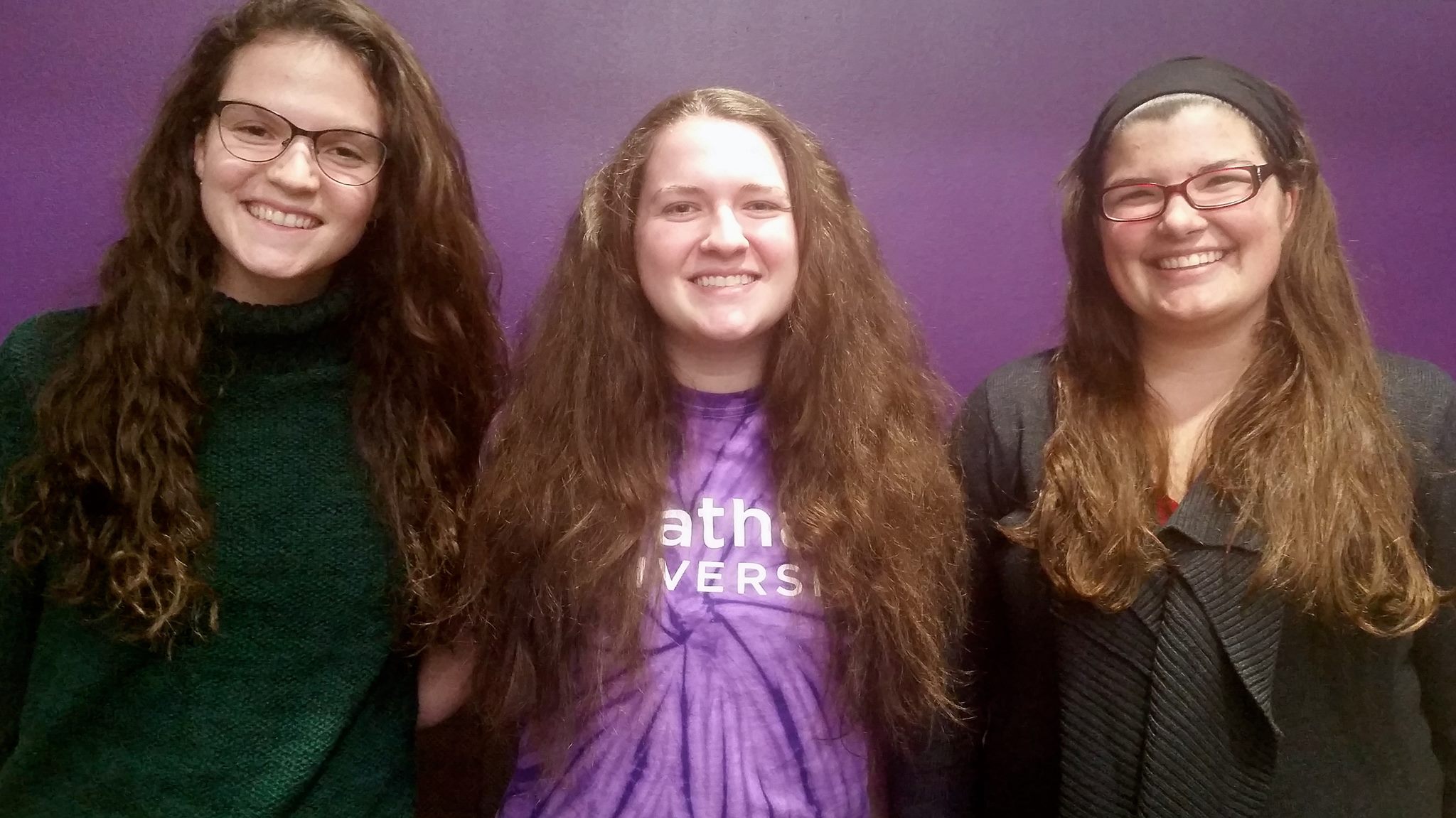Chatham’s Relay for Life is coming up quickly; and with a goal of $25,000, Chatham community members are coming together to raise funds. From student organizations to academic departments, RFL teams are being created left and right to help fight cancer one dollar at a time through the American Cancer Society.
One special group was formed this year by sophomores Kaitlyn Shirey and Krista Arena and junior Fia Nicoloso. Cleverly named “Loose Ends,” these three ladies have made a Relay team focused on cutting their hair for charity. They are using their locks as an incentive to receive more donations. The more people donate, the more they will cut.
What are you doing and what is your goal?
“[We’re] collecting donations for the American Cancer Society to get research and to help the families of those suffering,” said Arena, who is cutting more hair with the more donations she receives. Shirey on the other hand, is planning on going all the way.
“My goal is to raise as much money as possible for Relay for Life and to donate all of my hair,” said Shirey. “When I say all of my hair, I mean that I want to actually shave my head bald. Let no hair go uncut!” Shirey plans to sell the opportunity to take the scissors to her hair at Relay for Life. Anyone willing to donate will be able to cut her hair.
“As a bonus to monetary donations, our team is going to donate our hair to Pantene Beautiful Lengths,” said Nicoloso. “It’s an organization that gives wigs to cancer patients who have lost their hair.”
Pantene Beautiful Lengths is a program that asks for eight inches of hair or an $8.00 donation that goes towards making free, real-hair wigs. Over 800,000 ponytails have been donated to them, making over 42, 000 wigs.
“I like that [Pantene Beautiful Lengths] uses all the hair that they possibly can to make free wigs for cancer patients,” said Shirey. “It turns out that there are a lot of ways to donate your hair, and Pantene is the best fit for me. I don’t want to throw rocks, but Locks of Love sells their wigs on a need basis. It is often the case that a person could make a bigger impact for cancer patients by selling their own hair on the Internet and donating the money to research than by donating hair to [Locks of Love]. Additionally, some organizations will take hair donations to clean the environment.”
Though Pantene asks for eight inches minimum for hair, they will still take your hair to use for other resources, some that help with environmental issues.
“Every time you get a trim you could send that hair to clean up oil spills,” said Shirey.
Why did you decide to use your hair as a donation?
“I have donated my hair about five times now,” said Arena. “As soon as it gets too long to deal with anymore, I want to cut it. I feel that since I am fortunate enough to be able to grow my own hair, I may as well donate it to someone who can’t rather than it being thrown away.”
“I’m cutting my hair to help support patients undergoing cancer treatment. Due to treatment, many cancer patients lose their hair. Hair is a funny thing. It’s not something we think about much until it’s taken away from us. Sometimes the gift of a wig can really boost the spirits of cancer patients and give them a little bit more autonomy in a rough situation,” said Nicoloso.
Why did you choose Chatham’s Relay For Life and the Pantene Beautiful Lengths?
“I chose to raise money through Relay for Life because many of my family members and friends have or had cancer,” said Nicoloso. “Some of them lost their battle, and some are still fighting, but no matter what, the support that events like Relay for Life are invaluable for patients and caregivers alike,” said Nicoloso.
RFL’s donations all go to the American Cancer Society so cancer research can be done, as well as campaigns such as the Great American Smokeout, and provide support for those who currently have cancer.
Did you know anyone else was cutting their hair? How did all three of you decide to do it together?
“I originally got the idea when Kaitlyn and I were talking about how much easier our hair would be to manage if we shaved our head. Then we thought about donating it, and the idea sort of just stemmed from there,” said Arena.
“I have donated my hair several times in the past- roughly every two years for a while now. I wanted to donate my hair soon and one day I brought it up at dinner with Kaitlyn and Krista. Eventually, we couldn’t stop talking about donating our hair, and once we got in touch with [Chatham Relay for Life president] Lynzy Groves, the whole thing just came together,” said Nicoloso.
How do you think people will react to your new hairstyle?
A big hair change is a lot for many people to handle. All three of the young women express that they are expecting shock from others and even themselves.
“I already know my dad will not be happy. But if the donations are high enough, and I end up cutting my hair really short — I’ve [wanted] to try it — I may as well make such a drastic change while I’m in college. I feel like everyone will be very surprised at first, because I am somewhat known for how long my hair is, ” said Arena, who has donated her hair before, but has since felt her hair length was becoming part of her identity on campus.
“I often wonder whether I’ll even look like myself or be recognizable after all my hair is gone,” said Shirey, who has had longer hair for most of her life and is making the largest change if enough money is donated. From over a foot of hair to shaving her head, everyone is in for a surprise.
“My family may be a bit more shocked. I honestly don’t know what any of them will say when they find out how much has been cut — hopefully, all of it,” she said. “[It will be interesting] when they see me for the first time.”
For Nicoloso, who has donated her hair a handful of times before, she says that she gets mixed reviews over the way her hair looks after a big chop.
“At the end of the day, I don’t care about other people’s reactions. It’s my hair, and I can do what I want with it. I’m not using it, so if I can donate it to someone who will genuinely appreciate it, then I’m more than happy to do so. Besides, my parents always told me that the difference between a bad haircut and a good haircut is two weeks,” said Nicoloso.
Relay For Life is from 12 p.m. to 12 a.m. on Feb. 5. “Loose Ends” will be cutting their hair at 7 p.m. in the AFC. To donate to their team, visit the Chatham event page on the Relay for Life website.





